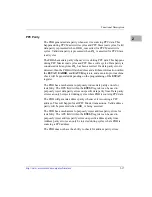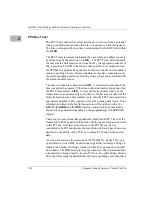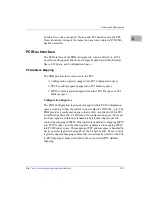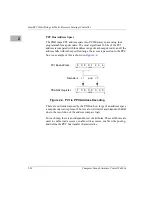
2-18
Computer Group Literature Center Web Site
Hawk PCI Host Bridge & Multi-Processor Interrupt Controller
2
PPC Bus Timer
The PPC Timer allows the current bus master to recover from a potential
lock-up condition caused when there is no response to a transfer request.
The time-out length of the bus timer is determined by the XBT field within
the GCSR.
The PPC Timer is designed to handle the case where an address tenure is
not closed out by the assertion of AACK_. The PPC Timer will not handle
the case where a data tenure is not closed out by the appropriate number of
TA_ assertions. The PPC Timer starts timing at the exact moment when
the PPC60x bus pipeline has gone flat. In other words, the current address
tenure is pending closure, all previous data tenures have completed, and
the current pending data tenure awaiting closer is logically associated with
the current address tenure.
The time-out function is aborted if AACK_ is asserted anytime before the
time-out period has passed. If the time-out period reaches expiration, then
the PPC Timer asserts AACK_ to close the faulty address tenure. If the
transaction was an address only cycle, then no further action is taken. If the
faulty transaction was a data transfer cycle, then the PPC Timer asserts the
appropriate number of TA_ signals to close the pending data tenure. Error
information related to the faulty transaction will be latched within the
ESTAT, EADDR, and EATTR registers, and an interrupt or machine
check will be generated depending on the programming of the ESTAT
register.
There are two exceptions that dynamically disable the PPC Timer. If the
transaction is PCI bound, then the burden of closing out a transaction is left
to the PCI bus. Note that a transaction to the PPC60x registers is
considered to be PCI bound since the completion of these types of accesses
depends on the ability of the PCI bus to empty PCI bound write posted
data.
A second exception is the assertion of the XTOCLM_ signal. This is an
open collector (wired OR), bi-directional signal that is used by a bridge to
indicate the burden of timing a transaction has been passed on to another
bus domain. The PHB asserts this signal whenever it has determined that
a transaction is being timed by its own PCI bus. Any other bridge devices
listening to this signal understand that the current pending cycle should not
Summary of Contents for MVME5100 Series
Page 1: ...MVME5100 Single Board Computer Programmer s Reference Guide V5100A PG2 September 2001 Edition ...
Page 16: ...xvi ...
Page 20: ...xx ...
Page 28: ...xxviii ...
Page 62: ...1 34 Computer Group Literature Center Web Site Product Data and Memory Maps 1 ...
Page 278: ...3 88 Computer Group Literature Center Web Site System Memory Controller SMC 3 ...
Page 288: ...4 10 Computer Group Literature Center Web Site Hawk Programming Details 4 ...
Page 320: ...Index IN 12 Computer Group Literature Center Web Site I N D E X ...
















































